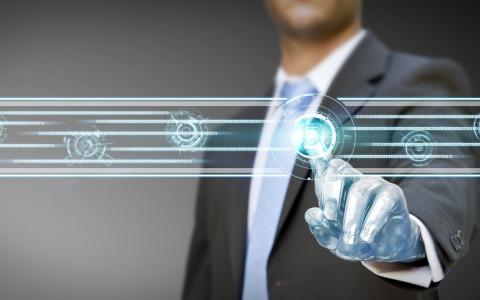
Last December, a U.S. National Security Strategy (NSS) declared AI “critical to America’s economic growth and security,” but warned that China and other countries have attempted to “steal U.S. intellectual property” in the field of AI.
To be fair, China has made great strides lately in strengthening its own enforcement of patent rights. Nonetheless, the NSS warned that stronger efforts were needed by U.S. companies to “curtail intellectual property (IP) theft by all sources” of our cutting-edge AI research.
But as telecommunications giant AT&T and other firms can attest, only human intelligence can stop the theft of artificial intelligence.
AT&T deploys a sophisticated suite of AI tools to manage the nearly 200 petabytes of data traffic that flows through its global telecommunications network every day.
AT&T’s artificial intelligence system may be smart enough to manage a vast communications network, but like a clever dog that can’t recognize itself in the mirror, it lacks the ability to tell when its own software brains are being pilfered for use in other companies’ products and services.
So to protect its patented AI innovations, AT&T deploys a unique “human search engine” called Article One Partners (AOP) to scout out IP theft.
The group is a crowdsourced network of 42,000 researchers in 170 countries speaking 114 languages — 42% of whom have graduate degrees in a variety of science and technology fields.
Acquired last year by the global intellectual property services firm RWS, Article One Partners got its start a decade ago as a “patent troll killer” working for defendants in high-stakes patent infringement suits.
There, its sleuths earned a reputation for finding patent-busting prior art in hidden corners of the globe that non-human algorithms and Internet search engines could never reach — an unpublished Korean-language PhD dissertation in an academic laboratory, a handwritten document in a rural Norwegian library, even an old camera lens in a NYC pawn shop.
In each case, AOP’s research proved that a patent troll’s supposedly “novel invention” wasn’t so novel after all, thereby invalidating the patent.
But in recent years, AOP investigators have begun to make a name for themselves in a burgeoning new field called Evidence of Use (EoU) research.
Working for tech clients like AT&T, for example, they search for evidence that the company’s patented innovations are being used without permission in other companies’ products and services. If they discover such evidence, it can be used to confront an infringer and force it to compensate the patent owner.
Here’s how human EoU research works. Say a company has a patented AI technology used in wireless products. In a hypothetical example, suppose the claims of the patent refer to:
“A wireless communications network having a plurality of node systems, each node comprising:
“a local clock having an input and an output for providing a timing signal;”
“a virtual master clock processing means for calculating the value of a virtual master clock for the node system;”
Followed by hundreds of additional words of highly-technical description written in the incomprehensible language of patents.
AOP’s research team translates the unintelligible patent claim into functional terms that anyone can understand — in the example above, “a technology that allows wireless devices to synchronize their internal clocks to a master clock across a wireless network.”
Once they’ve identified the desired functional capability, AOP researchers then consider the types of products or services that might perform this function.
In this day and age, time-synchronized wireless capability is found not only in smartphones but also in cars, home security systems, dishwashers, rice cookers, and virtual electronic assistants like Alexa — all of which have at least some degree of AI capability and can be remotely programed by users to perform certain functions at certain times under certain conditions.
AOP sleuths then launch a global investigation to analyze the products in question. They physically go to retail stores and trade shows all over the world — something no AI algorithm can do — and examine products suspected of performing the wireless synchronization function.
They also carefully review product literature, technical manuals, quick start guides, sales collateral, instructional videos, and product support FAQs written in dozens of languages.
But AOP’s findings are considered legally-admissible “evidence of use” only if they show that another company’s products perform the same wireless synchronization function in exactly the same way using exactly the same technological means as described in the original AI patent.
If they do, the client can then present the evidence to the other party and ask it to buy the patent or license the technology and pay the appropriate royalty. If the infringer refuses, the client may then be forced to exercise other legal remedies.
EoU research can uncover not only patent infringement, but counterfeit knockoff products as well.
A Google search may reveal the scale and cost of counterfeiting worldwide, but it can’t actually identify any of it in the marketplace.
Only humans can do that.
So in 2016, a global licensing organization for a hi-res storage technology used in many popular consumer products asked AOP to find out where unlicensed devices were being sold.
The group sent its detectives into retail stores in major cities around the world to take six pictures of every box with a product claiming to have the advertised technology — one photo of each side of the box.
The goal was to see if the product packaging displayed the appropriate serialized label proving it had been properly licensed.
According to AOP’s CEO Pete Vanderheyden, his investigators produced photos of unlicensed products from dozens of manufacturers. “And mind you, this was unbiased, third party, time-stamped evidence,” he added. “Very admissible in court.”
Their evidence enabled the licensing organization to collect millions of dollars in new licensing revenues. It also helped the organization improve its licensing control practices to reduce this type of counterfeiting in the future.
This is just one more reason why humans — especially those with skills — will never be obsolete.



